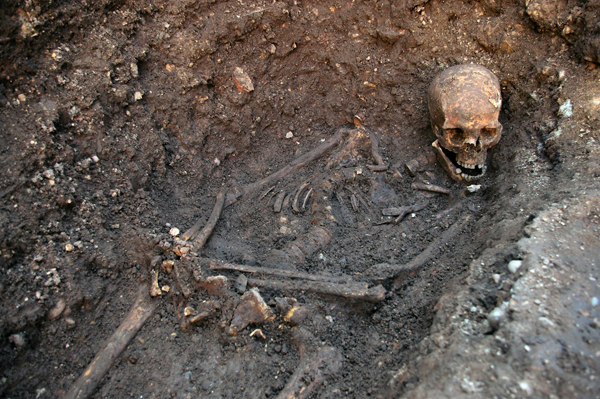The Dig for Richard III, authorized by the Leicester City Council and commissioned and paid for by Philippa Langley of the Richard III Society, unearthed a body and it was declared that of Richard III.
But not everyone was convinced. In an interview with BBC History Magazine, Michael Hicks, head of history at the University of Winchester, and Martin Biddle, archaeologist and director of the Winchester Research Unit, raised concerns about the DNA testing, radiocarbon dating, damage to the skeleton and that the excavation field records have remained sealed by the University of Leicester.
They argue that the remains could belong to a victim of any of the battles fought during the Wars of the Roses. The 1485 battle of Bosworth, where Richard was killed, was the last significant one and the location of the grave in the former site of the Grey Friars priory matches information provided by John Rous, an associate of Richard’s, but lots of people could have been buried there. Hicks also questions their use of radiocarbon dating. “Such a technique is imprecise,” he said. “It will give you an era, but nothing more. In this case, it covers a period of 80 years.”
Richard III? Image ©University of Leicester
Still, the evidence is pretty convincing. A spokesperson for the University of Leicester released a statement saying, “The identification was made by combining different lines of evidence, including:
- The location of the grave matches the information provided by John Rous, a contemporary and one-time friend of Richard III’s.
- The nature of the skeleton – including the age of the man, his general build, the injuries inflicted around the time of death and the scoliosis (spinal condition) - are also in agreement with historical accounts.
- The radiocarbon dating places the date of the skeleton to the period of Richard III’s death.
- Preliminary isotope analysis suggests an individual with a high-quality diet.
- The nature of his burial /grave is also highly unusual for Leicester at the time, but fits with the known facts around Richard’s burial.
- Two direct female-line descendants of Richard’s sister, Anne, were found to share a rare mitochondrial DNA type with the skeletal remains.
"The strength of the identification is that different kinds of evidence all point to the same result. We have made freely available a wealth of information on our website. A number of other papers are in preparation presenting the research on the skeleton (including the wounds and possible weapons that caused them), the scoliosis, stable isotope analysis, DNA, and other aspects of the discovery.
"Professor Hicks is entitled to his views but we would challenge and counter them. Our forthcoming papers will demonstrate that many of his assumptions are incorrect. We have already presented evidence in peer-review journals and will continue to do so in the months to come. In line with normal archaeological practice, we intend to make the site archive available to the public in due course, following publication of the results."
Professor Lin Foxhall from the School of Archaeology and Ancient History said, "The identification of Richard III is not based solely on the DNA, radiocarbon and scoliosis evidence, but on a combination of many different lines of evidence, which analysed and evaluated together, all point in the same direction. Most of the possibilities raised by Professor Hicks have been considered and eliminated, and the radiocarbon dating is sufficiently precise to ascertain that the burial is not one belonging to a much earlier period in the life of the friary.
"Much of the evidence for the identification is already freely available on our website in a basic form here. However, meticulous research and proper, peer-reviewed publication takes time, and we are still in the process of publishing the results of our research in academic venues. Papers on the DNA and on other aspects of the investigation are in the pipeline, and will be appearing in journals over the next few months. We anticipate that these will address the issues raised by Professor Hicks and Professor Biddle, and if not they are, of course, at liberty to write academic papers presenting the evidence to support their views – that, after all is the purpose of academic debate, and how knowledge moves forward! We will make as much of the data as possible openly available in due course, but, as is normal academic practice, not until our research is fully published."






Comments